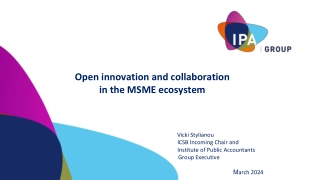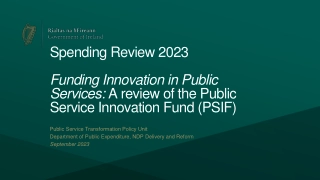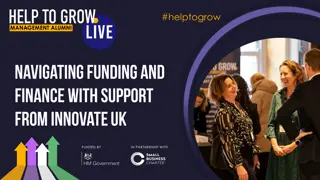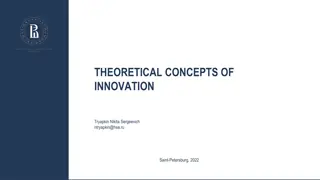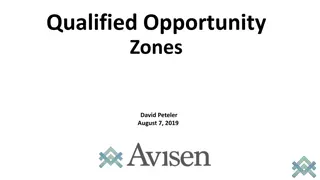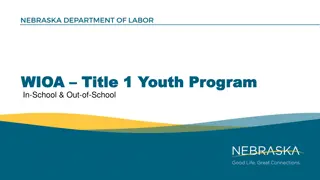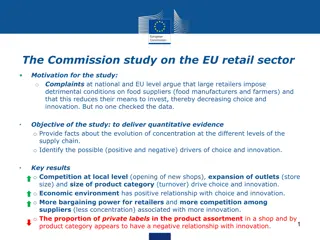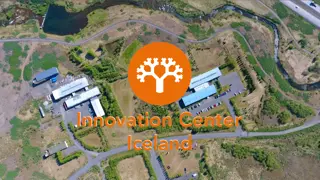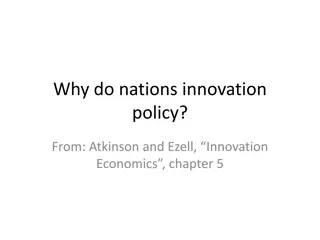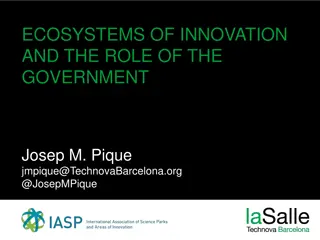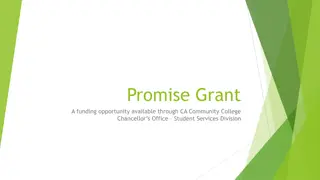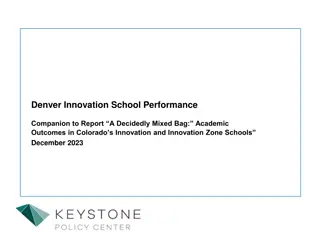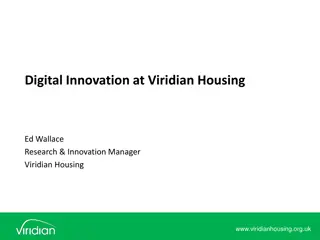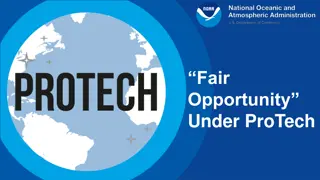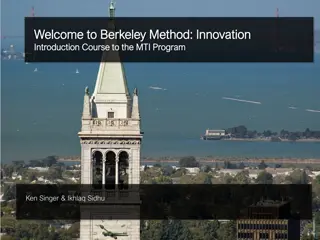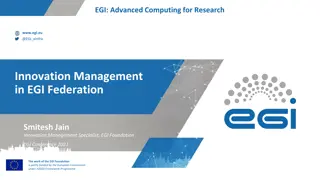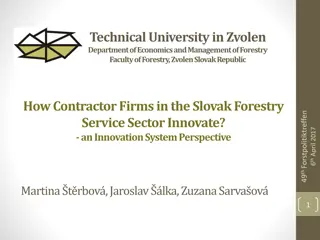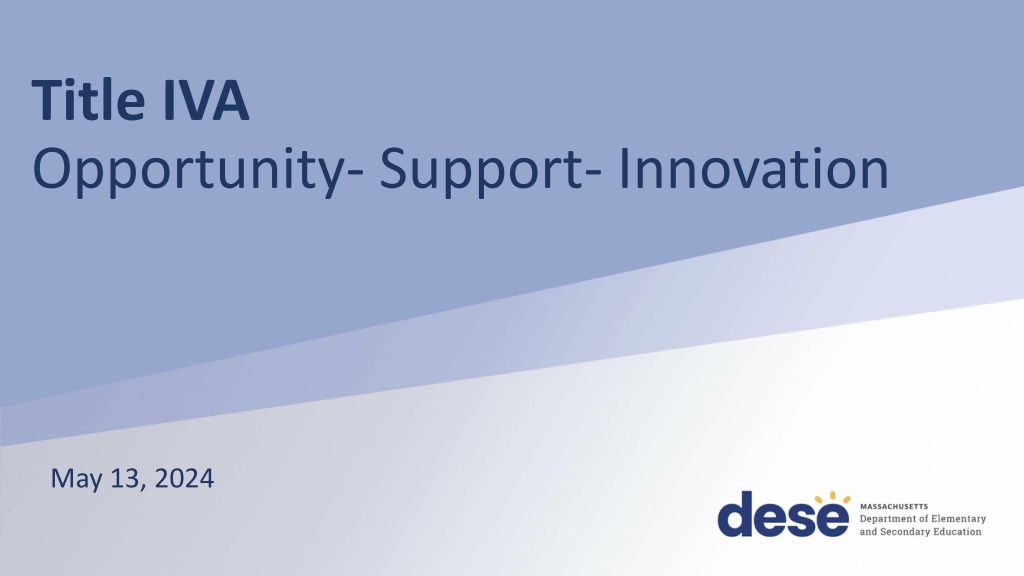
Understanding Title IVA Program Priorities
Explore Title IVA priorities, differentiate between needs and objectives, and learn how to evaluate program impact to create safe, healthy, and supportive educational environments. Consider stakeholder consultation, fund usage, and equitable services for optimal student support.
Download Presentation

Please find below an Image/Link to download the presentation.
The content on the website is provided AS IS for your information and personal use only. It may not be sold, licensed, or shared on other websites without obtaining consent from the author. If you encounter any issues during the download, it is possible that the publisher has removed the file from their server.
You are allowed to download the files provided on this website for personal or commercial use, subject to the condition that they are used lawfully. All files are the property of their respective owners.
The content on the website is provided AS IS for your information and personal use only. It may not be sold, licensed, or shared on other websites without obtaining consent from the author.
E N D
Presentation Transcript
Title IVA Opportunity- Support- Innovation May 13, 2024 1
Session Objectives Learn about: Title IVA priorities Need vs. Objective/Activity vs. Outcome Stakeholder consultation requirements Evaluation of program impact Allowable/unallowable fund uses Additional program requirements Equitable services (private school participation) requirements 2 2
Questions To Consider How has my district previously used Title IVA funds? What drove the decision to use funds in that way? What do my students need the most? How are we supporting them to meet those needs? What can we do in addition to make more of an impact? How has my district consulted with families, students, and other groups to assess students needs? How can we engage these groups more effectively? How do you distinguish between "needs" and "wants"? 3 3
Title IVA Priorities Fund Code 0309: Creating Safe, Healthy and Supportive, High-Quality Educational Learning Environments for All Provide all students with access to a well-rounded education; Improve school conditions for learning to ensure safe and healthy students; and Improve the use of technology to improve academic achievement 4 4
Need vs. Objective/Activity vs. Outcome The activity is not the need: The need is something that students need for supplemental support for academic achievement. The activity is a program that you design that will provide that supplemental support. The purchase is not the activity: The activity is a program you will develop to meet your need. The purchases are items, personnel, materials, etc. that you need to effectively run the program. Performance measurements are data that should be collected: The new or enhanced program must be evaluated, and data must be collected to inform that evaluation. The goal is to provide evidence that your program met your student needs. 5 5
Need- Objective/Activity- Outcome (contd) Outcome is what you expect will happen when needs are met: The goal is not to complete the activity, the goal is to meet the need that was identified. So, the outcome describes what it looks like if the need has been met. A through-line connects the need to the program: Like a backward design process, you start with the need, anticipate the outcome, then design the program to produce that outcome. The evaluation is the assessment of that program in terms of how it met the need. Don t confuse needs and wants: Wants are nice to have and might have some benefit, but they also might not have any impact on students at all. Needs are things that students must have to support them in their academic achievement; they are necessary. There is flexibility and room for innovation, but still must be based on a demonstrated need. 6 6
Planning Your Activities Start with your needs: You determine your needs based on situations identified in your needs assessment that prevent student success or opportunities. It s all about the students and providing opportunities for success. Determine your intended outcomes: You want the observed situations that determined your needs to change, so think about what it would look like if these situations were different, in other words, the needs were not there. Develop a new or enhanced program: To change the situations creating need, you want to supplement your current practices with a program that adds additional supports that remove the barriers to learning you identified as a need. Your program will be the new set of opportunities you will put in place that will remove those barriers. 7 7
Planning Your Activities (contd) Clearly define your program: You want to make sure you have all the expectations for how the program will run clearly defined, so that you can accurately budget for resources, supplies, or equipment you need to effectively run the program. Develop your evaluation of this program: Plan to collect data that can demonstrate the effectiveness of your program. The objective of your evaluation plan for the program is to determine if the program caused the outcomes you specified. You ll need direct data on the program to prove that. Relying on summative assessments and data you already collect will not provide this evidence. Only data tied to the program will. SPECIFIC MEASURABLE ACHIEVABLE RELEVANT TIME-BOUND 8 8
Stakeholder Consultation Districts must develop its Title IVA application through consultation with: Families Teachers Principals Specialized instructional support staff Students Community-based organizations Local government representatives (e.g. local law enforcement agency, local juvenile court, local child welfare agency, or local public housing agency) 9 9
Questions to Consider with Stakeholders How connected are students to school? How strong are adult and student relationships at school? Do students have access to, participate in and succeed in a variety of curricular options beyond core academics? To what extent are students active participants in their own learning? How physically safe and emotionally safe do people feel at school? Do effective supports exist to ensure the success of marginalized student groups? Do students have access to and utilize nonacademic supports like counseling, social, and health services? How ready are students for career and college? To what extent do teachers and staff have access to professional development focused on the use of educational technology in the classroom? 10 10
Evaluation of Program Impact The Title IVA federal program requires that applications for funds include the program objectives and intended outcomes for their activities, and how the district will evaluate the effectiveness of these activities based on the intended objectives and outcomes. Activities focused on purchases cannot be effectively evaluated for any impact because the only objective or intended outcome of the activity is the purchase itself. To effectively evaluate an activity, it must be clearly defined in its actions: What will be done, how will it be done, who will do it, and most importantly, for what purpose will it be done? The question you want to answer with your evaluation is simple: Did the actions taken in the activity result in the intended outcome and meet the original objective? 11 11
Evaluation of Program Impact (contd) Effective evaluations have planned data collections throughout the implementation of the activity. If you wait until the end of the activity, and it turns out it did not meet your objectives, you have no recourse to fix the situation. However, if you collect data part way through the activity, that preliminary data might give you an indication of the effectiveness of your program. If you determine it isn t being effective, you have the opportunity to make changes, so that the next data collection might provide better results. Good evaluation processes aid in continuous improvement. 12 12
Title IVA Fund Use (Well-Rounded Education) Develop and implement a College and Career Advisory Program to work with Guidance Counselor Develop and implement a STEM lab (during school day or as after school enrichment) Offer music or art courses to increase student engagement Develop a course in theatrical sound and lighting design Partner with local government agency to provide opportunity to increase civic engagement Take a trip to Nature s Classroom Experiential, play-based Kindergarten readiness summer program Provide access to accelerated learning opportunities including Advanced Placement (AP) and International Baccalaureate (IB) programs, dual or concurrent enrollment programs and early college high schools 13 13
Title IVA Fund Use (Safe and Healthy Students) Strategies to reduce chronic absenteeism: Bullying prevention and intervention, Trauma- informed classroom management, Relationship building skills (e.g., social skills group) Strategies to improve student health: Suicide prevention, Comprehensive substance abuse prevention, Nutritional education, Comprehensive health prevention education (including sexuality education) Strategies to increase student safety: Partner with mental health agency to provide intense support for targeted students, design and implement a plan to reduce exclusionary discipline practices by providing a supportive learning environment for students with behavioral issues 14 14
Title IVA Fund Use (Effective Use of Technology) Build technological capacity through PD Carry out innovative blended learning projects Provide students in rural, remote, and underserved areas with the resources to benefit from high-quality digital learning opportunities Deliver specialized or rigorous academic courses and curricula using technology, including digital learning technologies and assistive technology Create Digital Citizenship modules (online safety, media literacy, cyberbullying etc.) Develop digital teaching and learning PLC 15 15
Title IVA Unallowable Uses Curriculum development, curriculum materials, or PD for core academic subjects Technology or devices to support activities/programs required to be provided under state or local rule or policy Leadership development Textbooks (unless for a supplemental targeted IVA aligned program) Awards, incentives, prizes, gift cards, etc. Fundraising activities Food (unless required to meet purpose of program such as ingredients for a supplemental nutrition class) Non-educational games, devices, and field trips Construction or major infrastructure enhancements 16 16
Title IVA Additional Requirements Districts receiving $30,000 or more must conduct a comprehensive needs assessment and must expend: At least 20% on supporting a well-rounded education; At least 20% on supporting safe and healthy students; and At least some amount on improving the use of technology Districts receiving less than $30,000 are: Encouraged, but not required, to conduct a comprehensive needs assessment May allocate funds to one or more of the priority areas Note: Regardless of the allocation amount, districts may not spend more than 15% on technology infrastructure of any amount supporting effective use of technology. However, there is no cap on expenditures for technology infrastructure, including software, when such infrastructure is supporting safe and healthy schools and/or well-rounded education. 17 17
Title IVA Additional Requirements (contd) Funds must supplement, not supplant, any non-federal funds that would otherwise be used to pay for the activity Enhance, expand, increase, or extend programs/services offered with state/local funds Districts are required to prioritize funds to schools based on one or more of the following criteria: o they are among the schools with the greatest need (as determined by the district); o they have the highest percentages of low-income students; o they are identified for comprehensive support and improvement; o they have consistently underperforming subgroups; and o they are identified as a persistently dangerous public elementary school or secondary school under section 8532 of the Elementary and Secondary Education Act (ESEA). 18 18
Equitable Services (private school participation) Only private schools within district boundaries eligible for Title IVA (Note: This is different than Title I.) Must consult with each private school to determine services Funds are NEVER provided directly to private schools Use third party provider or pay teachers/other staff through contract using district procurement policies Funds benefit students and NOT the school All instructional support, materials, PD, and activities must be SECULAR, neutral, non- ideological District maintains title to all materials, computers, or other items purchased on behalf of participating private schools Use good judgement; you don t have to take back everything, rather need to know that it s secure and owned by district *Exempt: charter schools, vocational/technical schools, and virtual schools* 19 19
Reflection Questions How has my district previously used Title IVA funds? What drove the decision to use funds in that way? What do my students need the most? How are we supporting them to meet those needs? What can we do in addition to make more of an impact? How has my district consulted with families, students, and other groups to assess students needs? How can we engage these groups more effectively? How do you distinguish between "needs" and "wants"? 20 20
Resources Federal Grant Program Liaisons by district: http://www.doe.mass.edu/federalgrants/liaisons.xlsx o federalgrantprograms@mass.gov o (781) 338-6230 Title IVA: http://www.doe.mass.edu/federalgrants/titleiv-a/ Grants Management: http://www.doe.mass.edu/grants/ o edgrants@mass.gov o (781) 338-6595 21 21



